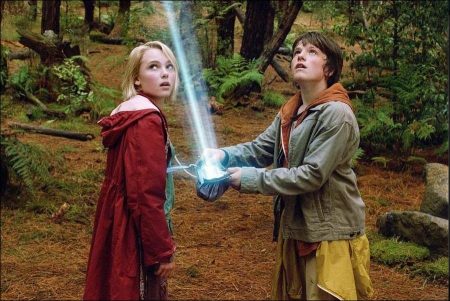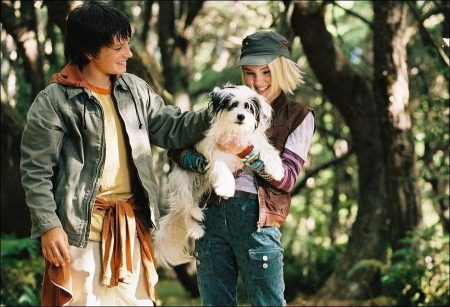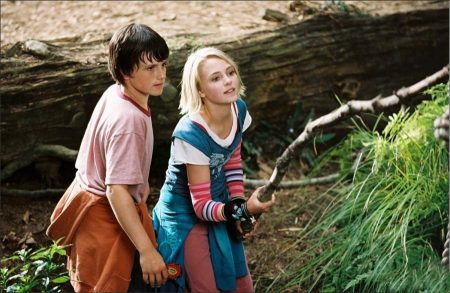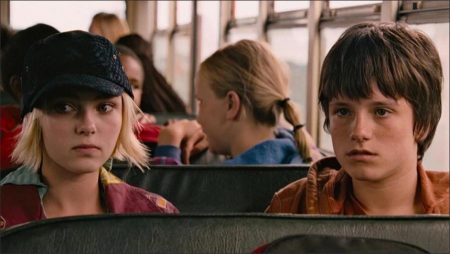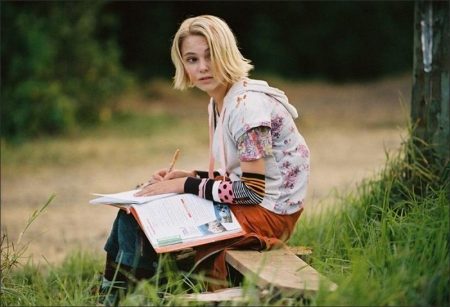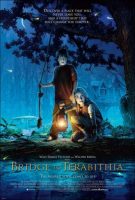Imagining Terabithia: The Film’s Design
As a movie that celebrates imagination, the production of Bridge to Terabithia would ultimately come to involve an entire team of exceptionally imaginative people— especially when it came to bringing the kingdom of Terabithia to life, just as Jess and Leslie do in the forest.
The task was unlike any other, because there was no map or blueprint to follow. Terabithia wouldn’t be based on any particular history, mythology or even on Katherine Paterson’s words, since she left the job of imagining Terabithia largely up to her readers. So here was a rare chance for the filmmakers to forge creatures and a whole kingdom out of thin air, as Leslie and Jess do—with total freedom. The creatures would be entirely wild, unlikely and flamboyant, yet would also be filled with the qualities of the real-life people from Leslie and Jess’s life who inspired their forms.
Jumping off from what was already put into the script, Gabor Csupo decided to bring in a man he considers a brilliant visual genius to turn out a series of gorgeously detailed illustrations. This was Dima Malenitchev, the award-winning visual thinker who had served as an art director at Klasky Csupo after coming to the U.S. from his native Russia. From his pen sprang the whimsical yet richly organic vision of Terabithia that Weta Digital would later create in three dimensions on the screen.
“Dima is an amazing conceptual artist,” says Csupo. “From the beginning, we talked about the idea of what Terabithia should be. We knew we did not want any cutesy creatures. Instead, I asked him to think about what would Terry Gilliam do, what would Ridley Scott do? I wanted the unexpected and a far more fantastical look than you might think you would see in this kind of movie. I wanted to really surprise the audience, both children and adults, with very unorthodox creatures.”
Csupo was especially aware that kids today are living in an intensely visual universe—and have highly sophisticated cinematic sensibilities. “We live in an age where you have video games and designs that are unbelievably complex, so I think with this kind of fantasy world, you really have to push the envelope so that kids aren’t saying, ‘Oh, I’ve seen that before,’” he says.
To the filmmakers’ delight, Dima Malenitchev was able to forge creations—ranging from a leafy Giant to fairylike Dragonflies to Hairy Vultures and, to top it all off, the Squogres, super-speedy, squirrel-like ogres based on the school bullies at Jess and Leslie’s school—that made the familiar seem entirely new.
“Dima’s creatures were incredible,” says Lauren Levine. “They don’t simply imitate other fantasy films but feel very different and create their own kind of world. We thought it was important to have the creatures completely emerge from Jess and Leslie’s real lives and from the forest they are in, and Dima’s illustrations hit the nail on the head.”
Adds Alex Schwartz, Executive in Charge of Production for Walden Media: “The creatures are very edgy and in keeping with the sensibility of kids today. It’s a real visual feast that I think will dazzle young audiences.”
Terabithia Comes Alive
There was only ever one top choice for who could handle Bridge to Terabithia’s visual effects with just the right mix of magic: Weta Digital, the visionary Academy Award-winning wizards who transformed the whole of Middle Earth into something palpably and unforgettably real for awed film audiences in “The Lord of the Rings.” Based in Wellington, New Zealand, Weta Digital is an artist-led facility that specializes in creating creatures—taking projects from conceptual design all the way through to state-of-the-art 3-D animation.
“Why go anywhere else?” asks producer Lauren Levine. “Weta is the best digital house in the entire world, and if you have a chance to work with the very best, you take it! Watching Weta turn the pictures of our Terabithian creatures into three-dimensional living and breathing beings was an unbelievable treat. They’re miracle workers, alchemists and geniuses.”
For Csupo, who is used to working in the entirely unreal realm of animation, seeing what Weta could create was awe-inspiring. “You look at these creatures, and you know they don’t exist, and yet it’s like, wow, are you sure they aren’t really alive? It’s really kind of spooky what they do,” he admits.
Richard Taylor, a director of Weta, saw Bridge to Terabithia as a perfect match for Weta Digital’s specialized art form—and a distinct challenge. “It was a very exciting project for us,” he says, “because it was a chance to make real a world that is very intangible. It’s not like ‘Lord of the Rings,’ where you can lock it all down to certain descriptions and cultural influences. These creatures in Terabithia are completely from inside the minds of children.
They’re make-believe in the best sense, which actually makes it harder to find visual solutions.” Taylor continues: “I devoured the script and I loved the subtle interplay between the real world and the fantasy world. It’s an incredibly heartfelt and touching story that reminds me of all the books and films I love the most. This kind of story that celebrates that spirit of creativity comes along so rarely.”
Once Weta came on board, another creative duo began to add their efforts to the mix: Weta’s visual-effects supervisor, Matt Aitken (who has worked on such films as “X-Men” and “Lord of the Rings”), and the film’s New Zealand-based production designer, Robert Gillies. The two worked very closely with one another to assure that every aspect of the film’s design—both the real and the fantastical—would be woven together as a piece.
“The collaboration between us added to the quality of the design,” notes Aitken. Adds Gillies: “Our creative process was a bit like a ball game—one of us would take the ball and run with it and then kick it off to the other person.”
Aitken’s work began by taking Dima Malenitchev’s drawings and turning them into moving, leaping, stunning 3-D images. “The illustrations are incredibly evocative, but they’re still in two dimensions. It’s not the same as, say, taking a photograph of a Squogre or a Hairy Vulture, which is what we really needed to do,” Aitken explains. “So the first thing we did is explore what these creatures would really be like in three dimensions through a lot of experimentation. Then we start making computer models, adding in the skin, the hair, the fur, the feathers and other fine details.”
He continues: “We go through a lot of iterations for each character, figuring out each and every nuance of the facial expressions and how their hair and skin moves. And we do this for a long time before we even start putting the characters into the film’s shots.”
Adding more complexity to the creatures is the fact that many are hybrids—mergers that mix imaginary beasts and monsters with qualities of real-life humans back in the real world. To create this effect, the Weta team referenced photographs of several of the actors in the film, then enmeshed subtle details with their wholly imaginary creations. Explains Aitken: “For example, the Squogre involves subtle elements of Cameron Wakefield, who plays Jess’s schoolmate Scott Hoager, and the Hairy Vultures are a combination of a crow with Elliot Lawless, who plays Gary Fulcher, while the Giant has elements of Lauren Clinton, who plays the bully Janice Avery.”
Most everyone on the set developed a favorite creature of his or her own. The Giant especially struck Gabor Csupo’s fancy. “It’s an extremely beautiful creation, and I love that this is a character who turns out to be something different than what it first appears, who takes a wonderful emotional turn,” he says.
While Aitken focused on creatures in the computer, Gillies was working with hammer and saw, building key sets including a traditional farmhouse for Jess’s home and, perhaps most spectacularly, the tree house that becomes the launching pad for Leslie and Jess’s creation of Terabithia. “For building the tree house, you had to kind of tap into your inner kid,” comments Gillies. “Although we started with an illustration that Dima had drawn, we went into the forest in New Zealand and built the house according to the trees we found there, just like any kid would in any woods around the world.”
In further enhancing—not to mention enchanting—the look of the film, Gabor Csupo also worked closely with two-time Academy Award-nominated cinematographer Michael Chapman, aka Chappy, who has shot more than 40 feature films, ranging from Martin Scorsese’s “Raging Bull” and “Taxi Driver” to the action classic “The Fugitive.”
“I was so happy when I heard Michael was going to do the film because he is like a legend,” says Csupo. “And then he came in to talk with me and he was like an excited child. He acted really humbled and said, ‘This is such a beautiful story, and it’s exactly the kind of movie I want to do at this time in my life.’ So I knew it was going to be great.”
Csupo continues: “We work together very well because Michael has a very different mindset from mine. “He’s very practical-minded and, with his 40 years of experience in the movie industry, I couldn’t have been happier than to have a great pair of eyes like his.”
With the decision to use Weta Digital as the visual-effects house, it made sense to shoot the film in New Zealand, but it wasn’t until Csupo arrived in that lush island nation that he realized just how perfect the natural environment there—rife with pristine forests and awe-inspiring landscapes filled with a sense of possibility—was for a film about turning reality into fantasy.
“Auckland is already a magical place,” Csupo says, “and there’s so much talent there.” Between the natural beauty of New Zealand, the eye-popping digital creations of Weta and the powerful performances from the cast, Bridge to Terabithia began to come alive on celluloid, just as it had in the hearts and minds of every child who had ever read the book.
For David Paterson, seeing the story that had begun with his own childhood heartbreak come so thrillingly to life brought everything full circle. “It’s been a long, long journey, but it’s been completely worth it,” he says. “To continue the legacy of this story is wonderful, because in the end, it’s always going to be friendship and imagination that keep the world going.”
Bridge to Terabithia (2007)
Directed by: Gabor Csupo
Starring: Josh Hutcherson, Anna Sophia Robb, Zooey Deschanel, Robert Patrick, Bailee Madison, Kate Butler, Emma Fenton, Grace Brannigan, Patricia Aldersley, Lauren Clinton
Screenplay by: David Paterson, Jeff Stockwell, Kevin Wade
Production Design by: Robert Gillies
Cinematography by: Michael Chapman
Film Editing by: John Gilbert
Costume Design by: Barbara Darragh
Set Decoration by: Jackie Gilmore
Art Direction by: Roger Guise, Jennifer Ward
Music by: Aaron Zigman
MPAA Rating: PG for thematic elements including bullying, peril and mild language.
Distributed by: Buena Vista Pictures
Release Date: February 16, 2007
Visits: 195
